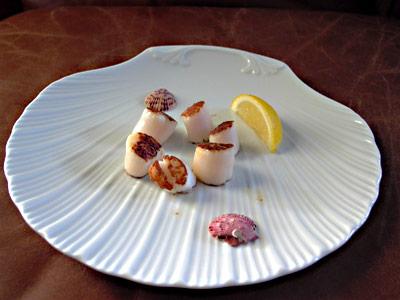Seasons by the Sea: Sweet Morsels From the Bay

Growing up, I was lucky to live close to the Chesapeake Bay. This meant an abundance of blue crabs and bay scallops.
As a young bride I often prepared a certain scallop dish for company. Boy, was it bad! But I didn’t know it at the time. I would dredge those sweet, tiny morsels in flour, then sauté them, then dump some garlicky tomato sauce on them and cook them for another 15 to 20 minutes. The flour thickened the tomato sauce in a nasty way, and the way-too-long cooking time made the scallops taste like rubbery little garlicky nubbins. What a waste.
I’ve learned a lot about scallops since then, about their fragility, perishability, and their right to be left alone so that their sweetness can shine.
This is a good year for bay scallops, they are plentiful and priced fairly reasonably. They are good raw, with a squeeze of lemon and a pinch of sea salt, in ceviches, quickly seared, and yes, even good when floured and cooked briefly in tomato sauce.
In America, we tend to only eat the adductor muscle of the scallop, while the “rims ’n’ roe” are prized in Europe and Canada.
What makes scallops so sweet? They are full of the amino acids glycine and glycogen, a portion of which is gradually converted by enzymes into glucose when the animal is killed. When sautéed, they quickly develop a rich brown crust thanks to this combination of free amino acids and sugars.
There are approximately 400 species of scallops that range from a few millimeters in size to a yard across. Most food scallops are harvested from the ocean floor. Sea scallops are usually dredged from deep, cold waters year round. The smaller bay and calico scallops are either dredged or hand-gathered by divers closer to shore during a defined season, like right now. Calico scallops are smaller and have less flavor than bay scallops and must be partially steamed to get them out of the shell. They are sometimes sold as bay scallops but are easy to recognize; they are pale white and opaque around the edges, kind of like baby marshmallows. Bay scallops are cream-colored, slightly pink, or orange and have an appealing sheen.
When purchasing shucked scallops, avoid those that are pure white, brownish, or dull looking. It’s okay to ask if you can smell them. They will have an odor, but it shouldn’t be strong. Try to buy scallops of a similar size so they’ll cook evenly. It is a common practice for some scallops to be soaked in water to which tripolyphosphate has been added.
This is to help preserve the freshness and add a little more weight to them. This is, however, catastrophic when the scallops are sautéed because the water runs out as soon as the scallops get hot. Wholesalers sell scallops labeled “wet” or “dry” but retailers are not required to pass this information on to you. Soaked scallops often look pure white and seem to merge together. Scallops that have not been soaked retain their ivory to pink to orange hue and remain separate.
While you must be sure your scallops are super fresh, they are probably the safest shellfish to eat raw. All shellfish filter large amounts of seawater to obtain nutrients. Bacteria, viruses, and toxins tend to accumulate in this filtration apparatus. The filtration apparatus in scallops is discarded and only the adductor muscle (where few toxins accumulate) is eaten.
Enjoy these special and delicate treats while they are in season. Their life span is a mere 24 months, so you never know from year to year how abundant the supply will be.
___
Click For Recipes
